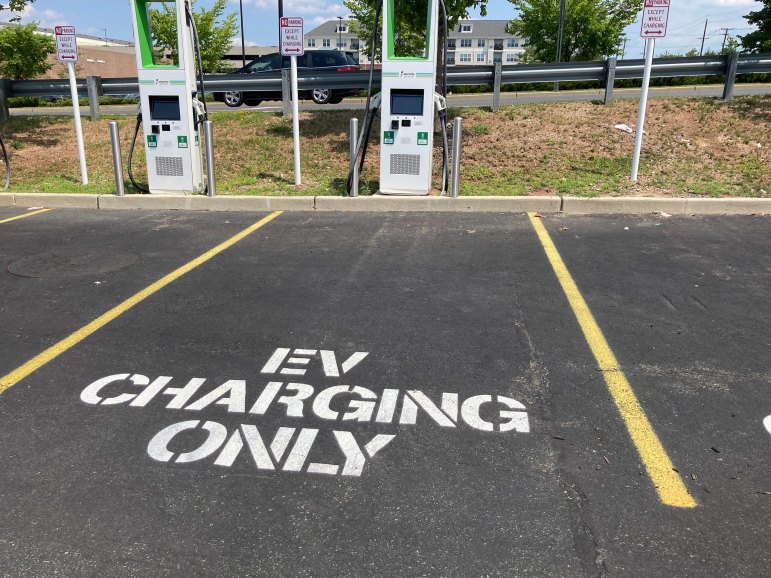
Over the course of more than a century, the fueling infrastructure for gasoline cars has matured to a point where drivers rarely have to think about it. Find a gas station, swipe a credit card, and fill up the tank. We’ve come a long way from buying gasoline from a barrel at the pharmacy to fill up the Model T.
While electric vehicle charging stations are more common, it is still an infrastructure in its infancy. And even though electricity is more or less universal, it is the chargers themselves – and how people use them – that are proving to be the sticking point.
CNN journalist Peter Valdes-Dapena experienced this first-hand recently, on a relatively short road trip on the I-95 corridor between New York and Philadelphia. While Valdes-Dapena had no problem locating a high-speed charging station, he was stuck waiting in line for several hours behind other drivers taking a long time to charge up.
What’s taking so long? Fast-charging beyond a certain capacity, say, 80%, can damage EV batteries. So, many cars are programmed to stop fast-charging at that point and charge more slowly to top off the battery. That means drivers, accustomed to filling up the tank as they would a gasoline car, can cause delays as they stay plugged in until the battery reaches 100%.
Electrify America has a solution for these so-called “charger hogs” – cutting drivers off at 85% and charging an additional fee to remain at the charger, potentially cutting wait times in half.
While that particular problem has a relatively simple solution, drivers are also encountering chargers that don’t work at all, eroding trust in public charging infrastructure and, in turn, electric vehicles themselves, as recently reported by Canary Media.
That problem is compounded by a patchwork of chargers developed and operated by different companies. Which means collaboration will be key.
“When drivers say the charger doesn’t work, there’s a complex set of reasons why the charger doesn’t work,” ChargerHelp’s CEO Kameale Terry told Canary Media. “It’s not as simple as a gas station. And to fix something that complex, we need to take a more collaborative approach.”
Part of that collaborative approach is standardizing and sharing data – so that common issues can be identified and technicians trained to fix them.
“The car experience is great — people like electric vehicles,” Terry said. “We have a gap in infrastructure, and now we have to come together to figure out what to do about it.”
More clean energy news
✌️ They knew: A compilation of government documents shows climate change was discussed in Congress and the media in the 1960s and 1970s, including a Nixon administration report that said “the greatest consequences of air pollution for man’s continued life on earth are its effects on the earth’s climate.” (Grist)
🔌 Getting connected: The Department of Energy awards $2.2 billion in grants to eight transmission projects that, matched with $10 billion in private investment, are expected to support 13 GW of new clean energy. (Canary Media)
🏭 Inefficient coal: Indiana is emblematic of a larger problem as utility-owned coal plants are dispatched despite the availability of cheaper resources like wind and solar, costing ratepayers hundreds of millions and contributing to air pollution. (Energy News Network)
📈 Carbon market scrutiny: A key oversight body says nearly one-third of the carbon offset credits on the market do not meet its standards, a sign of further upheaval in a process that is already heavily criticized. (Bloomberg)
🌡️ Climate impacts: Low-income households are increasingly vulnerable to extreme heat, highlighting the urgency of ensuring equitable access to electricity and energy efficiency measures, advocates say. (Associated Press)
🏢 Staying cool: Massachusetts awards $53 million — with plans for additional funding — to allow affordable housing operators to execute energy efficiency retrofits to reduce carbon emissions, cut energy bills, and create healthier, more comfortable homes for residents. (Energy News Network)
🤖 Solar machine: Renewable energy company AES introduces a pickup truck-sized robot that it says can install heavy solar panels twice as fast as humans can and at half the cost. (New York Times)
⚛️ Fusion breakthrough?: A company developing a nuclear fusion prototype at a Tennessee nuclear plant raises capital from enthusiastic investors who see potential for an alternative to creating nuclear power from fission. (Knoxville News Sentinel)
☀️ Waste to energy: Inflation Reduction Act funding will support multiple Ohio solar projects on former landfills and at a retiring coal plant. (Energy News Network)
📢 We want to hear from you! Send us your questions, comments, and story tips by replying to this email.
💸 Support our work: The Energy News Network is powered by support from readers like you. If you like Energy News Weekly, share it with a friend! Or give today and help us keep our news open and accessible for all.
📧 Want more energy news? Sign up for our daily digests.
